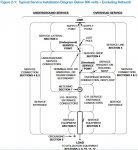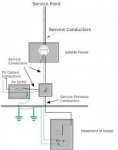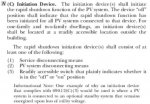PVfarmer
Senior Member
- Location
- Newport County, Rhode Island, USA
So would I. I’ll see what I can bring up to make it more declarative. I’ll tell you though, I’ve brought this up before and some people seem to think it’s clear that it is not a service entrance so they block adding any wording to that effect.
It seems clear to me that an AC PV disco is part of the service entrance- I think it is at the "load end" of the service entrance, and it is service equipment.
It has service conductors or service entrance conductors on the grid side, and PV output conductors on the PV side, and it cuts off the PV from the grid.
But it could be clearer for sure.
Service conductors and service entrance conductors are defined in code- I don't see where "service entrance" is used by itself without conductors right after.
NatGrid says this-
Service entrance:
That part of the Customer's wiring from the point of attachment or termination
of the service lateral or service line to and including the service equipment.
^^ That means service entrance = everything from drip loop (when overhead) to breakers or fuses.
These defs. are 2017 code, Art.100.
One thought is that the _______ after load end of service conductors might say... "or load end of service entrance conductors"?
The service entrance conductors are a subset of service conductors, and the former is not always part of the setup.
I like that Info Note at the bottom
---
Service Equipment.
The necessary equipment, usually consisting of a circuit breaker(s) or switch(es) and fuse(s) and
their accessories, connected to the load end of service conductors ______ to a building or other structure, or an otherwise designated
area, and intended to constitute the main control and cutoff of the supply.
Service Conductors.
The conductors from the service point to the service disconnecting means.
Service Conductors, Overhead. The overhead conductors
between the service point and the first point of connection
to the service-entrance conductors at the building or other
structure.
Service Conductors, Underground. The underground conductors
between the service point and the fIrst point of connection
to the service-entrance conductors in a terminal box,
meter, or other enclosure, inside or outside the building wall.
Informational Note: Where there is no terminal box, meter,
or other enclosure, the point of connection is considered to
be the point
Service-Entrance Conductors, Overhead System.
The service conductors between the terminals of the service
equipment and a point usually outside the building, clear of
building walls, where joined by tap or splice to the service
drop or overhead service conductors.
Service-Entrance Conductors, Underground System.
The service conductors between the terminals of the service
equipment and the point of connection to the service lateral
or underground service conductors.
Informational Note: Where service equipment is located
outside the building walls,there may be no service entrance
conductors or they may be entirely outside the
building.
(my note, as in: a supply side PV system OCPD and j-box, outside...or...a MDP for a house, outside- no service entrance.
When PV OCPD/j-box are outside and house MDP is inside, it's service entrance conductors to house, service conductors to PV OCPD)






